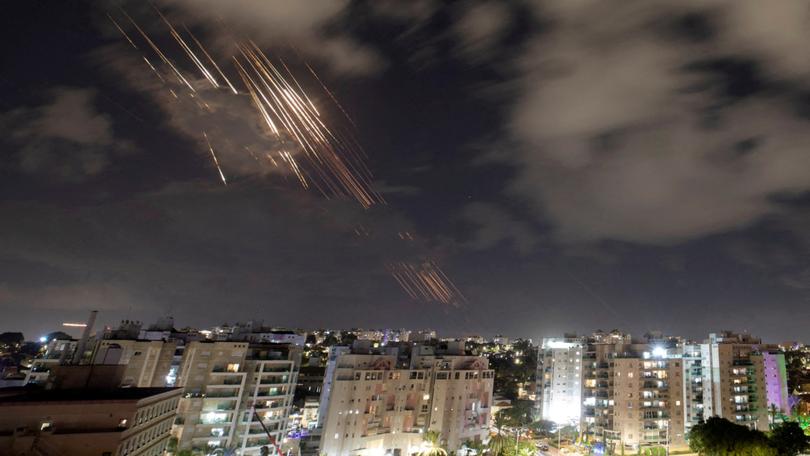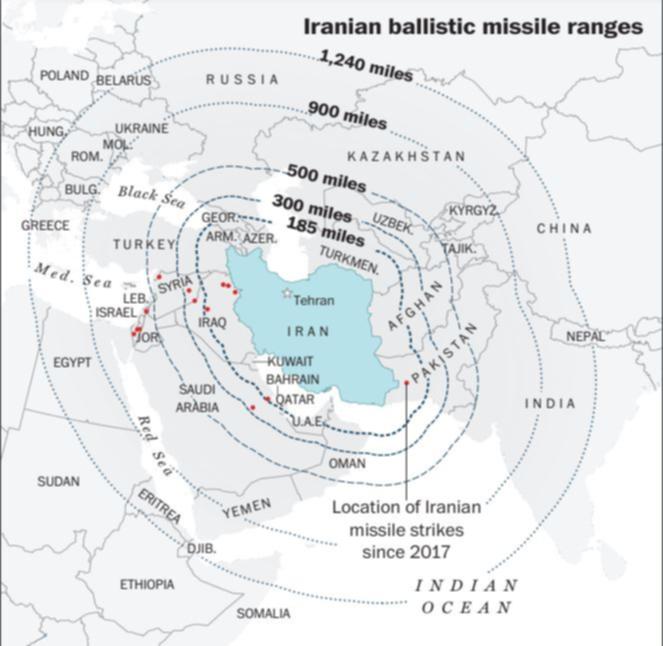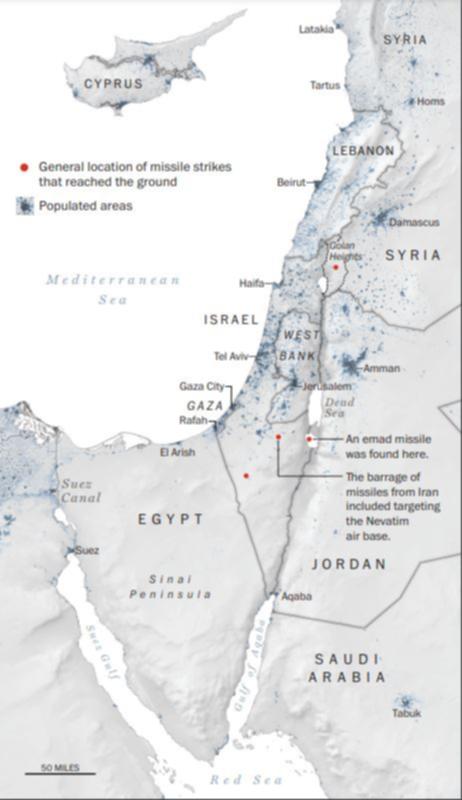What Iran’s April attack on Israel revealed about its weapons arsenal

This story was first published on April 17 after Iran’s first missile attack on Israel. On Oct. 1, Iran targeted Israel in a second barrage, which analysts said reflected lessons learned from the earlier attack.
Iran’s first direct attack on Israel in April demonstrated the country’s military might and the advances of its domestic weapons program, analysts said, while also revealing the limitations of its arsenal.
With more than 300 drones and missiles launched in a layered onslaught, it was Iran’s largest-ever conventional show of force. That it inflicted only minimal damage was due in part to the choreographed nature of the attack - giving Israel and the United States ample time to prepare air defense systems - but may also be attributed to shortcomings in its medium- and long-range capabilities.
Sign up to The Nightly's newsletters.
Get the first look at the digital newspaper, curated daily stories and breaking headlines delivered to your inbox.
By continuing you agree to our Terms and Privacy Policy.“The operation showed that our armed forces are ready,” Iranian president Ebrahim Raisi told crowds gathered in April in Tehran to mark Army Day. Parades in the Iranian capital featured many of the same munitions used in the attack on Israel.
Raisi hailed the attack as a resounding “success,” but was also quick to qualify the strikes as “limited” and “not comprehensive.”
“If it was supposed to be a large-scale action, nothing would have been left of the Zionist regime,” he said. And if Israel retaliates, Raisi pledged, “they will be dealt with fiercely and severely.”
Yet after analyzing the munitions used in the April assault and the success of regional defense systems, researchers say it’s unclear how Iran could inflict greater damage on Israel through conventional military means.

“Iran basically threw everything it had that could reach Israel’s territory,” said John Krzyzaniak, a researcher who studies Iran’s missile programs at the Wisconsin Project on Nuclear Arms Control. Like other analysts interviewed for this story, he spent several days studying launch videos, imagery of debris and interception information to identify the Iranian munitions.
His conclusion is that Tehran “used some of every system they have.” And experts said it made sense that the Sejjil-1 and Shahab-3 missiles were excluded from the attack.
Shahab-3 “wasn’t used because it’s so old,” said Fabian Hinz, an Iran analyst at the International Institute for Strategic Studies in Berlin. “The Sejjil is a bit of a mysterious missile,” he said, adding that Iran has “used it very, very little during maneuvers.”
Other analysts noted the Sejjil was expensive to produce and may no longer be in production.
The quantity of munitions used also provides new insights into Iran’s capabilities. The deployment of over 100 ballistic missiles in a single wave suggests that previous estimates that Iran has about 3,000 ballistic missiles stockpiled are probably accurate, and could even be on the low end.
“If this is just round one of an unknown number of rounds to come, you wouldn’t fire a significant fraction of what you have just in the first round,” Krzyzaniak said.
The firing of over 100 ballistic missiles in the space of a few minutes suggests Iran has at least 100 launchers, he added - a new data point for researchers.
“This shows that Iran has really faced no limitation in domestically producing missiles and launchers,” he said.

Iran’s ballistic missile arsenal, the largest of any country in the Middle East, is almost entirely homegrown. In recent years, Iran has demonstrated the ability to upgrade some systems, improving their range and precision.
The spokesman for Iran’s armed forces, Abolfazl Shekarchi, said the munitions used in the strikes against Israel only represented “a fraction of” the country’s military’s might, according to a statement published on state-run media.
Before the attack on Israel, Iran’s most significant use of ballistic missiles was in 2020, after a U.S. drone attack killed the powerful Iranian commander Qasem Soleimani.
Iran launched more than a dozen ballistic missiles at two U.S. military bases in Iraq, one in the country’s west and one in the north. While there were no fatalities, dozens of U.S. service members suffered traumatic brain injuries.
Iran also used ballistic missiles in strikes this year on Pakistan, Syria and Iraq.

But the attack on Israel suggests that many of Iran’s munitions are of low quality. Israel’s military said 99 percent of the missiles and drones launched by Iran were intercepted or failed to launch.
“We saw that accuracy and precision are a work in progress,” said Behnam Ben Taleblu, a senior fellow at the Foundation for Defense of Democracies who has written extensively about Iran’s missile program. “These weapons alone won’t win a war for Iran.”
Iranian drones made up the first wave of the attack. Cheap, effective and easy to produce, Iranian drones have been used in attacks across the Middle East for years. Iran has also supplied drones to Russia for its war in Ukraine, where they have been deadly.
During the attack on Israel, the slow-moving drones were probably deployed to occupy air defenses and allow more advanced munitions to get through. All the drones were shot down before entering Israeli airspace, the Israel Defense Forces said.
Ali Hamie, a Lebanese military analyst, said Iran had probably gleaned important lessons about Israel’s aerial defenses. Commentators on Iranian state television have made similar points.
“It could be a testing attack,” Hamie said, “and the Iranians got what they want. Making it past the air defenses is not only a symbolic victory, but real victory.”
One of the few missiles to make it through the interceptors hit an Israeli air base in the Negev desert. Images of the strike were run on loop on many state-run Iranian broadcasters in the days after the attack. Israel characterized the damage as minor.
In addition to analyzing Israel’s air defenses, Tehran will probably also be studying the problems with its missile systems that reportedly led to failures at launch and in flight, according to Afshon Ostovar, a professor of national security affairs at the Naval Postgraduate School in California.
“Another attack could be more effective,” he said. But ultimately the kind of approach demonstrated in the attack “is not really sustainable over a long-term conflict.”
Even if Iran changed the tempo of attacks and adjusted the munitions used, “they would still have to launch quite a lot of stuff for just a few [munitions] to get through,” he said.
Some Iranian officials have suggested they have held back their most dangerous weapons.
“We are prepared to use weapons we have never used before. We have plans for every scenario,” said Abolfazl Amoui, a parliamentary national security spokesman, in an interview with Lebanese broadcaster Mayadeen.
But analysts say it’s unlikely that any one type of munition could be a game changer. Rather, it’s more likely Iran would use the same kinds of munitions in a future attack, but in a different way: giving less warning, or launching the barrage in concert with allied militant groups in the region. The country’s proxy forces, from Lebanon to Iraq to Yemen, played little role in the assault.
As Israel mulls its response, Tehran has warned that a counterattack would come in “a matter of seconds.”
“Iran will not wait for another 12 days to respond,” Deputy Foreign Minister Ali Bagheri Kani said.
While the United States and Israel have celebrated thwarting the attack, analysts are urging humility.
“The number of munitions it took to repel the attack was enormous, costly and could be difficult to replicate,” said Tom Karako, the director of the Missile Defense Project at the Center for Strategic and International Studies.
“Israel may have gotten lucky and Iran may have gotten very unlucky.”
William Neff and Suzan Haidamous contributed to this report.
© 2024 , The Washington Post
